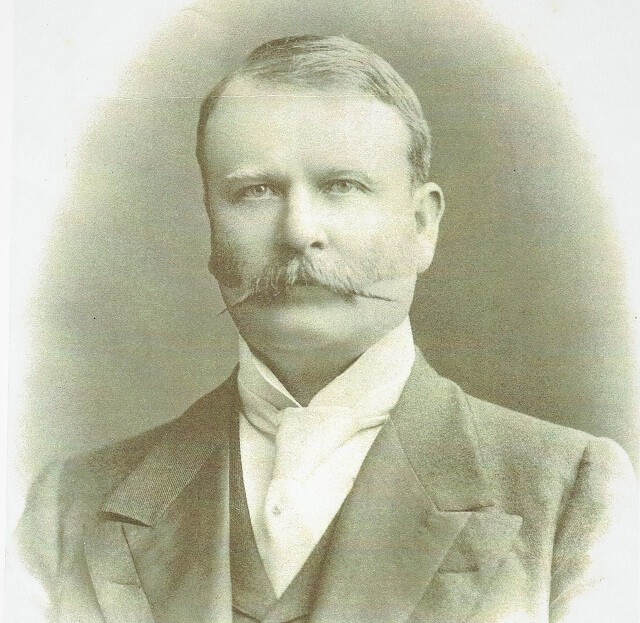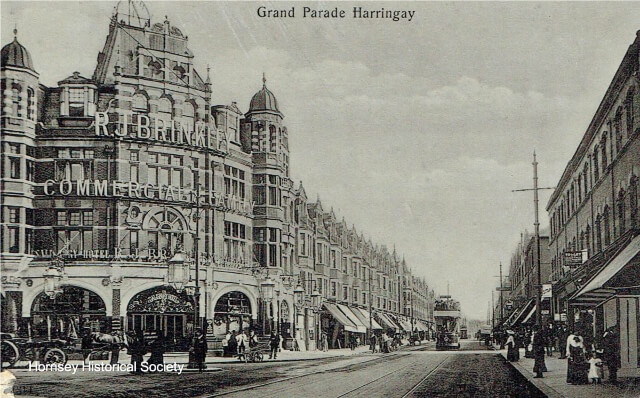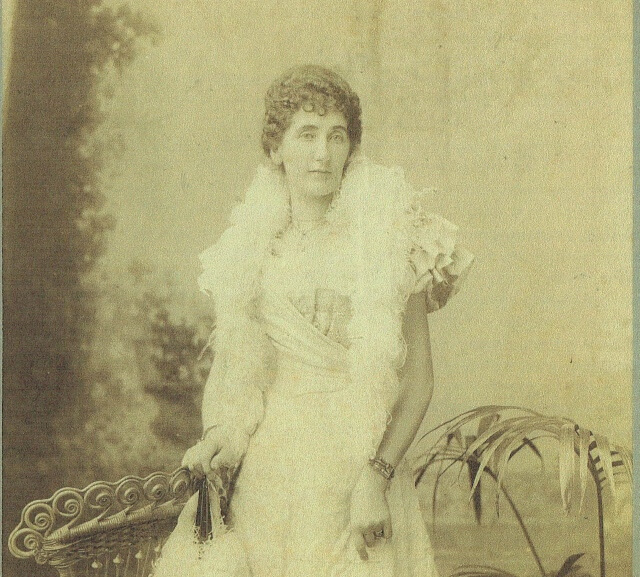
John Cathles Hill (1857 -1915) was, ‘a very remarkable man of immense energy and vision’. So wrote his grandson, JEB Hill, in May 1997, to Joan Schwitzer, HHS Chairman. JC Hill built up large parts of North London, founded The London Brick Company and became one of the richest men of his time. He lived at Southwood Hall from 1894 until 1905.
Early years
J C Hill’s story was ‘rags to riches’ personified. Born on 12th December 1857 in Dundee, Scotland, to Robert Hill, a carpenter, and his wife Elizabeth, his father succeeded his own father as tollbooth keeper in Auchterhouse, combining it with a wheelwright and joinery business. John and four siblings grew up accustomed to hard work and strict Scottish Presbyterians ethics. After apprenticeship, he left home at 17 becoming a self-employed journeyman carpenter and jointer. Moving across Scotland he reached Glasgow where he attended the Mechanics’ Institute (technical college), learning the principles of architecture and construction. In 1878, aged 21, he journeyed to London by sea.
J C Hill, the self-made entrepeneur
Arriving in fast expanding North London he quickly secured a job; he was a foreman within a fortnight and a master joiner within a year. The 1881 Census records Hill, aged 23, living in Albert Road, Tottenham, a builder employing eight men. He found a useful contact in a relative John Cathles Porter who had a speculative builder’s business in Hornsey. Through joinery contacts, Hill increased his capital to £150. He started building houses, realising the enormous potential for development in the leafy suburbs north of Islington. He acquired an Archway office near the boundary between London and Middlesex.
His houses were for middle class tenants with jobs in the City or West End, a hugely expanding market. The first housing developments had clustered around railway stations resulting in densely packed working class districts with few amenities. Hill provided neighbourhood shopping parades with good facilities and put in managers, or himself, to run slow-letting shops until they were profitable and saleable.

Somewhat surprisingly considering his strict Presbyterian background, he designed and built grand, lavishly decorated, public houses. It is two of these which are well known locally today – the Queen’s Hotel in Tottenham Lane, Crouch End, famous for its art nouveau stained glass and mahogany fittings, and The Salisbury in Green Lanes, Harringay, which had a large billiard room, spacious bar, plus a restaurant and concert hall on the first floor. Both were on new sites and needed new licenses, difficult to obtain in the 1890s. Hill overcame local opposition and won over the licensing magistrates. The Salisbury opened in 1899 and The Queens in 1901.
J C Hill the brick factory owner
An insufficiency of bricks for his building projects led Hill to the brickworks of Fletton, Peterborough. He bought a moribund works on seven acres of clay and grandly named it ‘The London Brick Company’. The bricks had a high carbonaceous content producing lighter bricks than his competitors and cheaper to transport. Hill bought more acreage, opened more brickworks and the business thrived. He installed a huge kiln called ‘Napoleon’, the biggest in the world, producing 750,00 bricks a week.
Making Fletton his second home, he moved his parents down from Scotland and took an interest in local government. Hill was a paternalistic employer, remembering his own humble and frugal background. He was concerned to see his brick workers represented in their trade with decent houses to live in. He funded annual outings to Yarmouth for his entire workforce and their families, though, like a strict father, he retaliated to striking brick workers by locking them out and forcing them back to work.
Moving up in the property market to Southwood Hall
In 1882 J C Hill had married Matilda Mose, a grocer’s daughter. Records show that they attended St John’s Presbyterian Church in Tottenham where their first child, Constance, was baptised in 1883. By 1886 Hill had moved his family to his business at 32 Archway Road and by 1890 he had taken them to The Neuk, 71 Whitehall Park, the largest house in a street he probably developed. The next move, c.1894, to Southwood Hall, the Highgate end of Muswell Hill Road, demonstrated how prosperous he had become.
This pseudo-gothic mansion with its carriage drive and sweeping lawns round the house was ideal for a business man eager to flaunt his wealth. Hill was a generous host and held house parties in its four reception rooms with a billiards room for the gentlemen and 10 bedrooms and dressing rooms for his guests.

He still worked hard in business in North London and in public life in Fletton. Matilda Hill took little part in her husband’s activities, but did own several plots of brickmaking clay around Fletton. Her time would have been taken up running a large household with a live-in staff. Nevertheless, it was she, not John, who was a member, 1894-1903, of the Highgate Literary & Scientific Institution (HLSI).
Hill’s world comes crashing down at start of 20th century
Hill had financed all his ventures by an optimistic reliance on mortgages while acquiring the land and using newly built houses as security. This system worked well when business was booming but when recession hit there was a dramatic reduction in cash flow from the sale of houses to pay interest and repay mortgages. Disaster struck when the mortgages were called in. Hill had large contracts for supplying bricks also.
The Hills could no longer afford to live at Southwood Hall and moved into a mansion flat, 1 Linden Gardens on Shepherds Hill, possibly built by Hill on the site of old Linden House. Later they moved to No.7. They were there when their daughter Constance was married at Highgate Presbyterian Church, Highgate, in July 1906. It was a lavish affair though the reception had to be held at The Gatehouse not at home. The parents’ present to bride and groom was an impressive rosewood Bechstein grand piano.
In May 1912 at the age of 55, Hill was declared bankrupt with a deficit of over a million pounds. He blamed Lloyd George’s 1909 Budget with its proposal for a 20% tax on unearned income arising from the sale of land. This shattered the confidence of builders and mortgagees alike. His creditors moved in. Hill was discharged from bankruptcy in January 1915 after what his grandson, JEB Hill, described as, ‘somewhat complicated financial arrangements between various banks and insurance companies since the properties mortgaged were still intact and occupied’.
He had poor health in later years. He died of a heart attack on 15 April 1915, aged 57, whilst on a visit to Hove, Sussex. He was laid to rest in a simple white marble grave surmounted by a cross in an unfrequented part of Highgate Cemetery; Matilda joining him in 1939. Today their grave is almost totally obscured by undergrowth.
From an article by Joan Schwitzer in HHS Bulletin 40 (1999), edited and augmented with new information by Janet Owen. This is the second article on interesting occupants of Southwood Hall. Henry Virtue Tebbs, is another, and if you haven’t already you can also read about the house itself, its use as a school and other interesting connections to the house.
Image Credits
HHS Archive